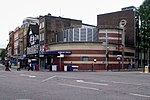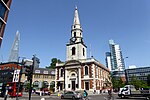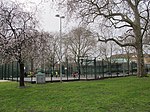Statue of Alfred the Great, Southwark
Cultural depictions of Alfred the GreatGrade II listed buildings in the London Borough of SouthwarkGrade II listed monuments and memorialsGrade II listed statues in LondonRoyal monuments in the United Kingdom

The statue of Alfred the Great in Southwark is thought to be London's oldest outdoor statue. The lower portion comes from a Roman statue dating to the late 1st or early 2nd century AD, while the top portion is a late 18th- or early 19th-century Coade stone addition in medieval style.
Excerpt from the Wikipedia article Statue of Alfred the Great, Southwark (License: CC BY-SA 3.0, Authors, Images).Statue of Alfred the Great, Southwark
Trinity Street, London Borough (London Borough of Southwark)
Geographical coordinates (GPS) Address Nearby Places Show on map
Geographical coordinates (GPS)
| Latitude | Longitude |
|---|---|
| N 51.498888888889 ° | E -0.093611111111111 ° |
Address
Trinity Street
SE1 1DF London, Borough (London Borough of Southwark)
England, United Kingdom
Open on Google Maps









